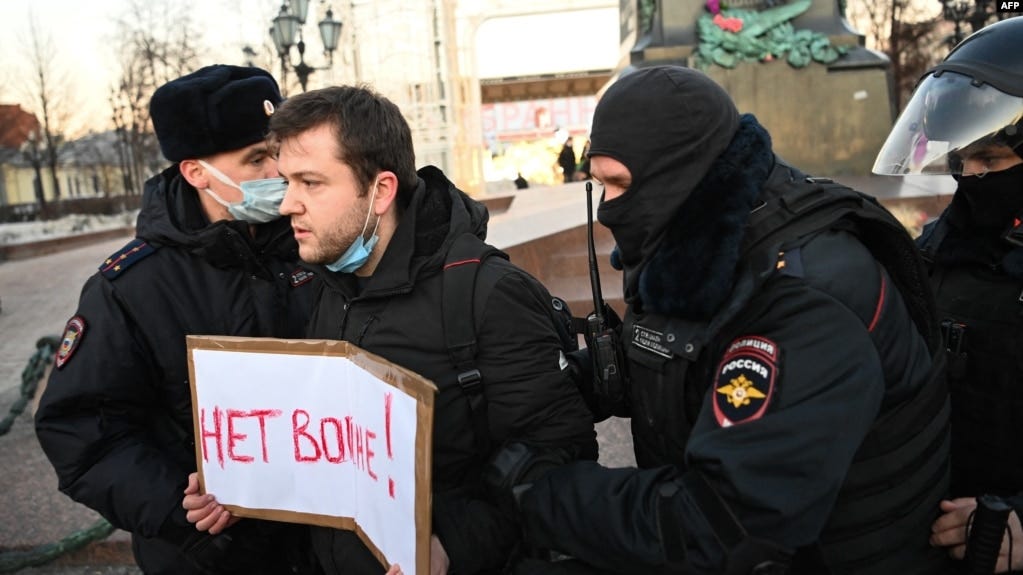Russia’s Anti War Protests Are Small But Hopeful Sign
A Groundswell Peace Movement Is Our Best Hope

Some good news amid the bad: There are Russians protesting Vladimir Putin’s war of choice in Ukraine. The questions is how large the peace movement is and whether, given the closed nature of Russia’s governing system and stranglehold Putin has on it, the movement can rally Russian citizens and force Putin to stand down and pull his troops from Ukraine.
As The New York Times reports, thousands were in the streets, but it is unclear how much these protests represent broader Russian public opinion. One protester, a 44-year-old named Anastasia, told the Times that more people needed to take to the street.
“Everyone must be here, it is the only way to show that something monstrous is happening,” she said, refusing to give her last name fearing repercussions from security services.
One reason more people are not out in the streets, the Russian writers Ilya Matveev and Ilya Budraitskis say, is that Putin “has essentially crushed the organized opposition in Russia.” That means
Mass demonstrations against the war are unlikely — there is no political force capable of coordinating them and participation in any street protest, including even a single-person picket, is swiftly and severely punished. Activist and intellectual milieus in Russia are shocked and demoralized by the events.
At the same time, they write, there is “no clear support for war is discernible in Russian society.” Nor is there backing for the pretext being used by Putin — protection of Russian speakers in Donetsk and Luhansk — at least according to public polling.
According to the Levada Center, the last independent polling agency (itself branded a “foreign agent” by the Russian government), 40 percent of Russians do not support the official recognition of the Donetsk and Luhansk “people’s republics” by the Russian authorities, while 45 percent of Russians do.
In the United States, as I wrote Sunday, it appears that the pundit class is banging the war drums. Most have stopped short of calling for American or NATO troops to intervene, but nearly all of them are calling for an aggressive and decisive response — the strongest sanctions possible. No one seems prepared even to ask what happens if the sanctions fail. (On the Trumpist right, many are siding with Putin.)
Let’s not mince words. Putin has moved from mere belligerence to an illegal invasion, a violation of international law, and very likely war crimes. There is no defending him. In that respect, I stand with Ukraine.
But what does it mean to stand with Ukraine, and is that enough? The prospect that this war will draw in others, including the United States, is being poo-pooed, but wars have a momentum all their own. They are unpredictable, as the disasters in Iraq and Afghanistan should remind us, a fact we rarely remember. As Katrina vanden Heuvel writes in The Nation, the just-commenced war “will embolden the hawks and armament-mongers on all sides.”
Already, armchair strategists are calling for doubling the US military budget, to grasp the “strategic opportunity” to bleed Putin in Ukraine, while pushing the Europeans to build up their military forces.
This is realpolitik run amok, a focus on strategy that ignores the human cost. Already, there are reports of casualties among Ukrainian soldiers and civilians, and thousands on the move (https://www.nytimes.com/live/2022/02/25/world/russia-ukraine-war/at-a-train-station-in-ukraine-many-flee-west-as-troops-move-to-the-front) across Ukraine fleeing the violence.
The West appears unified for now, but there are no guarantees that the unity will hold as sanctions against Russia take their expected toll on European economies.
I certainly cannot say how this will end. Like everyone else, I am watching and reading the news, looking for some hints of hope amid the bloodshed. Ukraine’s resolve and the small, but quickly assembled anti war protests organized in Russia offer us the most hope.



